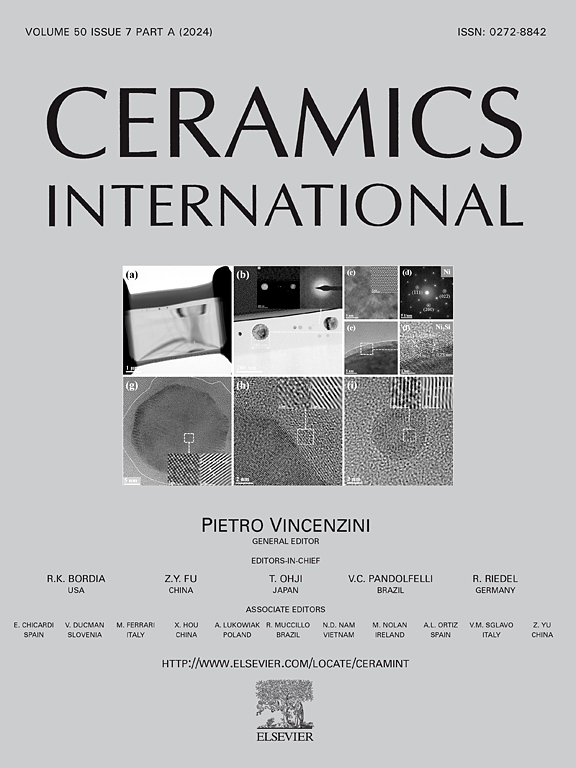用于 LTCC 技术的硼-镧系玻璃/Li2Zn3Ti4O12 陶瓷复合材料体系的烧结活化能和低温烧结工艺
IF 5.1
2区 材料科学
Q1 MATERIALS SCIENCE, CERAMICS
引用次数: 0
摘要
本文研究了用于低温共烧陶瓷技术(LTCC)的 B2O3-La2O3-MgO-TiO2(BLMT)玻璃/Li2Zn3Ti4O12 陶瓷复合材料在低温烧结过程中的润湿性、烧结活化能、相结构演变和行为特征。随着 BLMT 玻璃含量从 0 wt% 增加到 10 wt%,复合材料的平均烧结活化能 (Ea) 从 450 ± 8 kJ/mol 下降到 356 ± 37 kJ/mol。在 700 °C 烧结后,复合材料有两相:主相 Li2Zn3Ti4O12 和次相 LaBO3,后者从 BLMT 玻璃中析出。这表明 BLMT 玻璃促进了 Li2Zn3Ti4O12 陶瓷在 900 °C 以下的烧结。在玻璃含量为 20 wt% 或更高的复合材料中,烧结受液相烧结和反应粘性烧结的双重影响。随着 BLMT 玻璃含量的增加,粘性流动对致密化过程的影响变得更加明显。同时,当玻璃含量大于 20 wt% 时,玻璃会在 700 至 750 °C 之间析出 LaBO3、TiO2 和 MgLaB5O10 相。850 °C 之后,玻璃熔化并与 Li2Zn3Ti4O12 相发生反应,生成新的 TiO2 相。因此,烧结复合材料的活化能(Ea)从 393±17 kJ/mol 增加到 667±1 kJ/mol。本文章由计算机程序翻译,如有差异,请以英文原文为准。
Sintering activation energy and low-temperature sinterable process of Boron-lanthanide glass/Li2Zn3Ti4O12 ceramic composite systems for LTCC technology
This work investigates the characteristics of wettability, activation energy for sintering, evolution of phase structure, and behavior during the low-temperature sintering process of B2O3-La2O3-MgO-TiO2 (BLMT) glass/Li2Zn3Ti4O12 ceramic composites for low temperature co-fried ceramics technology (LTCC). As the BLMT glass content increases from 0 to 10 wt%, the average sintering activation energy (Ea) of the composite decreases from 450 ± 8 to 356 ± 37 kJ/mol. There are two phases the primary Li2Zn3Ti4O12 phase and the secondary LaBO3 phase, the latter precipitates from the BLMT glass after sintering at 700 °C. This indicates that BLMT glass promotes the sintering of Li2Zn3Ti4O12 ceramic below 900 °C. In composites containing 20 wt% or more glass, sintering is governed by both liquid-phase sintering and reactive viscous sintering. As the BLMT glass content increases, the impact of viscous flow on the densification process becomes more pronounced. Simultaneously, when the glass content is greater than 20 wt%, the glass precipitates LaBO3, TiO2, and MgLaB5O10 phases between 700 and 750 °C. After 850 °C, the glass melts and reacts with Li2Zn3Ti4O12 phase to produce a new TiO2 phase. Accordingly, the activation energy (Ea) of sintering the composite material increases from 393 ± 17 to 667 ± 1 kJ/mol.
求助全文
通过发布文献求助,成功后即可免费获取论文全文。
去求助
来源期刊

Ceramics International
工程技术-材料科学:硅酸盐
CiteScore
9.40
自引率
15.40%
发文量
4558
审稿时长
25 days
期刊介绍:
Ceramics International covers the science of advanced ceramic materials. The journal encourages contributions that demonstrate how an understanding of the basic chemical and physical phenomena may direct materials design and stimulate ideas for new or improved processing techniques, in order to obtain materials with desired structural features and properties.
Ceramics International covers oxide and non-oxide ceramics, functional glasses, glass ceramics, amorphous inorganic non-metallic materials (and their combinations with metal and organic materials), in the form of particulates, dense or porous bodies, thin/thick films and laminated, graded and composite structures. Process related topics such as ceramic-ceramic joints or joining ceramics with dissimilar materials, as well as surface finishing and conditioning are also covered. Besides traditional processing techniques, manufacturing routes of interest include innovative procedures benefiting from externally applied stresses, electromagnetic fields and energetic beams, as well as top-down and self-assembly nanotechnology approaches. In addition, the journal welcomes submissions on bio-inspired and bio-enabled materials designs, experimentally validated multi scale modelling and simulation for materials design, and the use of the most advanced chemical and physical characterization techniques of structure, properties and behaviour.
Technologically relevant low-dimensional systems are a particular focus of Ceramics International. These include 0, 1 and 2-D nanomaterials (also covering CNTs, graphene and related materials, and diamond-like carbons), their nanocomposites, as well as nano-hybrids and hierarchical multifunctional nanostructures that might integrate molecular, biological and electronic components.
 求助内容:
求助内容: 应助结果提醒方式:
应助结果提醒方式:


